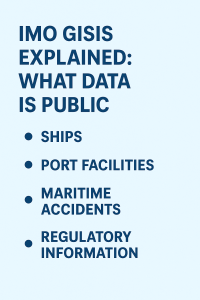Learn how IMO GISIS empowers maritime safety and compliance through public data. This step-by-step guide explores its structure, accessibility, and real-world applications in global ship transparency.
Why IMO GISIS Deserves Your Attention
Imagine you’re a maritime professional, a researcher, or even a policymaker trying to understand safety incidents, flag state performance, or port reception facility availability across the globe. You don’t have to search blindly anymore. Instead, there’s a trusted hub backed by the International Maritime Organization (IMO) – and it’s called GISIS (Global Integrated Shipping Information System).
In an industry where compliance, transparency, and access to real-time information are vital, GISIS has become an essential tool. Yet, many professionals are unsure of how to use it—or even what information is available publicly.
In this guide, we’ll walk you through what GISIS offers, how to use it effectively, and how its public datasets contribute to maritime transparency and operational excellence.

What Is GISIS?
GISIS is a centralized digital platform created by the International Maritime Organization (IMO) to collect and disseminate data related to maritime safety, environmental protection, and global ship operations. It provides both public and restricted data across several modules—from casualty reports to port reception facilities and flag state performances.
Launched in the early 2000s and continuously updated, GISIS supports the IMO’s regulatory objectives under conventions such as SOLAS, MARPOL, STCW, and ISM Code.
What Public Data Can You Access in GISIS?
While some data requires user login or Member State authority, a large portion of the GISIS database is publicly accessible—with no registration required. Here are the most valuable public data modules:
Ship and Company Particulars
You can look up IMO-numbered vessels and their managing companies. This includes:
-
Flag state
-
Ship type and tonnage
-
Classification society
-
Company safety management details
This data helps port state control officers, insurers, and researchers monitor ship compliance histories.
Casualty and Incident Reports
Under SOLAS Regulation I/21 and MARPOL Article 12, flag states are required to submit reports on marine casualties and incidents. GISIS makes many of these summaries public:
-
Fire and explosion incidents
-
Groundings
-
Collisions
-
Pollution events
🔎 Example: You can review over 4,000 records of incidents from 2008–2024 via the “Marine Casualties and Incidents” module.
Port Reception Facilities (PRF)
GISIS includes a comprehensive global list of port reception facilities that comply with MARPOL Annex I, II, IV, V, and VI requirements. This helps ship operators plan waste disposal at ports efficiently and legally.
As of 2024, over 3,800 facilities in 150+ countries are listed.
National Contacts and Authorities
Search for contact details of maritime administrations, search and rescue authorities, PSC offices, and more. This is crucial for emergency planning, regulatory coordination, and audit verifications.
Recognized Organizations (ROs)
You can identify classification societies and ROs authorized by flag states for surveys and certification, including those approved under SOLAS and MARPOL.
–
Why GISIS Data Matters for the Maritime Industry
With growing scrutiny on safety, decarbonization, and compliance, GISIS provides a level playing field of information. Here’s why that matters:
-
Port State Control can identify recurring deficiencies in ships or management companies.
-
Shipowners can benchmark fleet safety and performance.
-
Academics and analysts can access incident trends and performance metrics.
-
Governments and NGOs can improve regulatory development based on real-world insights.
IMO Secretary-General Kitack Lim has emphasized that GISIS supports “data-driven decision making for a safer and greener maritime sector.”
–
Step-by-Step Guide: Accessing Public Data on GISIS
Here’s a simplified guide to accessing GISIS without needing a password:
1. Visit the Official GISIS Website
Go to: https://gisis.imo.org/Public
You’ll land on a dashboard of publicly available modules.
2. Choose the Module You Want
Click on categories such as:
-
Marine Casualties and Incidents
-
Port Reception Facilities Database
-
Recognized Organizations
-
Ship and Company Particulars
-
National Authorities
Each opens a searchable database or downloadable reports.
3. Use the Search Tools
Most modules include filters such as:
-
Date range
-
Ship type
-
IMO number
-
Port/Flag State
For example, if you’re researching pollution incidents involving tankers between 2019–2023, you can filter and export those entries easily.
4. Analyze and Download the Data
Use GISIS as a data foundation for compliance checks, audits, or academic research. Note that the platform supports CSV/Excel exports for deeper analytics.
📝 Pro Tip: Combine GISIS data with Equasis, MarineTraffic, or Clarksons Research to generate high-impact safety and performance dashboards.
–
Real-World Application: Case Study on Flag State Control
Let’s consider the use case of Liberia’s Flag Administration. Liberia ranks consistently high on Paris MoU and Tokyo MoU white lists, partly due to proactive monitoring via GISIS.
According to a 2023 Lloyd’s List Intelligence report, Liberia used GISIS incident data to identify and retrain over 100 safety management companies whose vessels showed repeat MARPOL Annex I deficiencies in African ports.
This highlights how public and private sectors alike are leveraging IMO tools to improve compliance and accountability.
Benefits and Limitations of GISIS Public Data
Advantages
-
Open access for transparency and governance
-
Authoritative source validated by IMO Member States
-
Supports safety culture across stakeholders
-
Regularly updated with historical and current data
Limitations
-
Some reports are summarized; full versions may be restricted
-
Not all member states submit timely or complete data
-
Interface design is functional but not very modern (GISIS is due for a UX overhaul)
Emerging Trends in GISIS Use (2025 and Beyond)
Integration with AI Analytics
IMO and classification societies like DNV and ABS are collaborating to integrate GISIS data into predictive analytics for ship performance and safety trends.
Cross-Linking with Maritime Single Windows
With IMO’s 2024 deadline for mandatory Maritime Single Windows under the FAL Convention, GISIS data is being connected to national digital platforms for seamless reporting.
Support for IMO GHG Strategy Monitoring
GISIS is expected to play a stronger role in tracking compliance with the 2023 Revised IMO GHG Strategy, especially as IMO Data Collection System (DCS) and Carbon Intensity Indicator (CII) ratings evolve.
Frequently Asked Questions (FAQ)
What is GISIS and who can access it?
GISIS stands for Global Integrated Shipping Information System. Most data modules are accessible to the public; others require login for Member States and authorized organizations.
Is GISIS data reliable?
Yes. Data is submitted directly by flag states, port authorities, and recognized organizations under IMO conventions.
Can shipowners use GISIS to verify PSC histories?
Absolutely. The “Port State Control” and “Casualty” modules are frequently used by operators to understand inspection histories and safety trends.
Does GISIS offer live vessel tracking?
No, GISIS does not provide real-time tracking. For that, platforms like MarineTraffic or VesselFinder are more suitable.
How often is GISIS updated?
Updates vary by module. Some like PRF and casualty data are updated quarterly or monthly depending on submission frequency.
Can I download GISIS data?
Yes, most public modules allow you to export data in Excel or CSV formats for offline use.
Conclusion: Maritime Transparency Starts with Access
GISIS is more than just a database. It’s a gateway to understanding how our global maritime system operates, monitors safety, and promotes accountability. Whether you’re a ship manager looking to avoid blacklists or a maritime student preparing a thesis on port state control effectiveness, GISIS offers a goldmine of publicly available insights.
As the maritime industry pushes toward digitalization, data transparency, and sustainability, tools like GISIS will become even more critical.
📌 Explore GISIS now: https://gisis.imo.org/Public
References
-
International Maritime Organization. (2023). GISIS User Guide. https://gisis.imo.org/Public
-
Lloyd’s List Intelligence. (2023). Annual Maritime Risk Report
-
Paris MoU. (2024). Performance List of Recognized Organizations
-
UNCTAD. (2023). Review of Maritime Transport
-
Marine Insight. (2022). How to Use IMO GISIS Platform for Safety and Regulation Tracking
-
BIMCO. (2023). Data-Driven Risk Management in Shipping
-
Clarksons Research. (2024). Shipping Intelligence Network Reports


Spotless for the next tenant, took the stress out of moving. Using for every future move. Perfect move service.